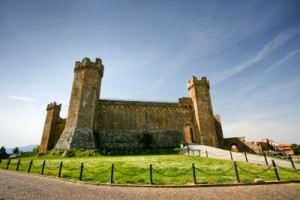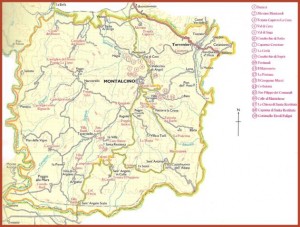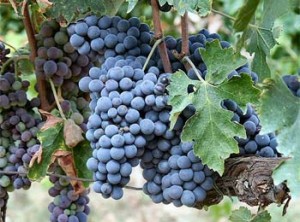Brunello di Montalcino – Could this be the true ‘King’ of Italian wines?
The story of Brunello embodies man’s quest for perfection. It begins with the discovery of a special grapevine on a steep Montalcino slope in 1842. That vine’s subsequent propagation by its founder, Clemente Santi, resulted in the creation of the Brunello wine.
Today, Brunello is considered one of Italy’s greatest wines and a supreme example of Sangiovese at its best. It has also become Italy’s most recognized premium wine, internationally. With a total production of 750,000 cases (9L), 65% finds its way into the world’s finest restaurants and connoisseur wine cellars. The United States has become the largest importer of Brunello, embracing 25% of the total production. Brunello’s international prominence was recognized by the Wine Spectator when it was selected the “Top Wine of the Year” in 2006.
In Italy at least it is the Piemontese Barolo that has assumed the moniker of being the ‘King of Wines’. Having travelled extensively in both Piedmont and Tuscany though I would contend that whilst this title was first bestowed centuries ago, given the choice I would usually go for glass of Brunello over one of Barolo.
With stage 3 of the Hannibal tour passing right through the heart the area in which Brunello is produced we thought we should at least give a bit of background on this most elegant of wines.
Brunello di Montalcino: Fast Facts
Production: 750,000 cases (9L), Vintage 2008
Vineyard Acreage: 4,700 acres
Grape Variety: 100% Sangiovese Grosso, although over 30 clones are used throughout the DOCG
DOC: Established in 1966; DOCG: Awarded in 1980
Minimum Alcohol: 12.5%; Maximum Yield: 3.2 tons/acre
Aging Requirements – Normale: Minimum of 4 years from January 1 after the harvest, 2 years in oak, 4 months in bottle.
Aging Requirements – Riserva: Minimum of 5 years from January 1 after the harvest, 2 years in oak, 6 months in bottle.
Now, the rest of the story…
The Place: The Montalcino zone takes its name from the town, which sits high on a hill as a fortified citadel with commanding expansive views in all directions. The zone encompasses 8,000 acres of vines, 4700 of which are dedicated to Brunello. The name, Montalcino derives from the Latin, “Mons Ilcinnus”, or mountain of holm oak. These oak trees grace the commune’s logo. Vineyards, while extensive, only cover 15% of the land, with forests, pastures, and fields of grain making up the rest. Indeed, Montalcino is like an elevated island amidst a sea of undulating wheat fields and pastures. The scenic beauty of the place won it a coveted UNESCO World Heritage Site award in 2004.
 Lying some 27 miles south of Siena and 27 miles east of the Tyrrhenian Sea, Montalcino enjoys a much warmer and drier climate than its Chianti Classico neighbor to the north, and Montepulciano to the east. This, together with diverse soils (including rocky “galestro,” limestone, marl, clay, and sand) make for growing conditions which consistently ripen its finicky Sangiovese grapes earlier the either Chianti Classico or Montepulciano. In Montalcino, harvest is normally completed by late September, usually before the arrival of the October rains.
Lying some 27 miles south of Siena and 27 miles east of the Tyrrhenian Sea, Montalcino enjoys a much warmer and drier climate than its Chianti Classico neighbor to the north, and Montepulciano to the east. This, together with diverse soils (including rocky “galestro,” limestone, marl, clay, and sand) make for growing conditions which consistently ripen its finicky Sangiovese grapes earlier the either Chianti Classico or Montepulciano. In Montalcino, harvest is normally completed by late September, usually before the arrival of the October rains.
The Montalcino Zone resembles a square formed by 3 perimeter rivers: the Ombrone on the north and west, the Asso on the east, and the Orcia on the south. It rises from the perimeter to a crest at the Poggio Civitella (2168 ft), a short distance south of the town, Montacino. There are presently four notable wine production areas.
- Just southeast of the town, the highest vineyards in the zone are located on steep terrain at an elevation of 1,300-1,600 feet. The site’s cool conditions favor slow ripening, producing wines that are more austerely structured, but are very age-worthy. Biond Santi’s “Il Greppo” estate is located here.
- Northeast of the town, on lower slopes, near Montosoli and Canalicchio, the terroir allows the wines to show fuller, riper qualities to complement their structure.
 Further north, toward the perimeter of the zone and at slightly lower elevations, the soil contains mainly clay with deposits of marl and sandy limestone. Areas such as Altesino and Catiglione del Bosco produce a more forward style of Brunello in this area.
Further north, toward the perimeter of the zone and at slightly lower elevations, the soil contains mainly clay with deposits of marl and sandy limestone. Areas such as Altesino and Catiglione del Bosco produce a more forward style of Brunello in this area.- Recent plantings in the southwest corner of the zone, near Sant’Angelo in Colle, Argiano, Pian della Mura, and Camigliano, have produced impressive wines with balance and structure. Here, sandy clay soils are often mixed with limestone and “galestro” at the higher sites. This area is closest to the sea and has a warmer microclimate.
The Grape: The name Brunello, meaning “the brown one,” came from the description of the Sangiovese Grosso grapes at harvest time – a dark colored, dusky brown berry. Brunello was the local name given to this type of Sangiovese Grosso, originally identified in 1842 by Clemente Santi. Today, the term is officially reserved for the name of the wine. Sangiovese grown in Montalcino has comparatively thicker skins, compared with grapes grown in other regions, and excellent anthocyanins. Both of these factors contribute to Brunello’s deep tannic structure and rich hue.
Sangiovese is Italy’s most planted single grape variety. It comprises 67% of the Tuscan vineyard acreage and is the main grape in 25 DOC(G)’s of Toscana. Sangiovese is an ancient grape, believed to have resulted from a spontaneous crossing during the Etruscan period. Recent DNA evidence reflects its parentage as a crossing between Ciliegiolo and Calabrese di Montenuovo.
However, there is significant diversity within the grape variety. Sangiovese tends to be genetically unstable and very adaptable; thus, many clones exist. Banfi Vineyards has documented over 600 versions of Sangiovese on their estate alone! Currently, as a result of extensive clonal research trials, the best clones are being propagated. Most estates are using multiple clones in order to add better balance and more complexity to their wines.
 The Wine: Brunello di Montalcino projects an image of majesty and mystery that heightens its allure. This aura was cultivated by the Biondi Santi family. For 100 years, they were the only producers of the wine. The Biondi Santi estate “Il Greppo,” where Brunello was born, has been called Italy’s first “grand cru”.
The Wine: Brunello di Montalcino projects an image of majesty and mystery that heightens its allure. This aura was cultivated by the Biondi Santi family. For 100 years, they were the only producers of the wine. The Biondi Santi estate “Il Greppo,” where Brunello was born, has been called Italy’s first “grand cru”.
However, the wine remained somewhat of an Italian secret until the 1960’s, when word began to spread about the tastings of the extraordinary Biondi Santi vintages of 1888 and 1891. Soon, the wine world turned its attention to this special place and its remarkable wine. The Biondi Santi family, led by Franco and his son Jacopo, carry the flag and continue to produce age-worthy Brunello at the family estate.
A growers’ consortium was established in 1967, and has become one of Italy’s most effective with 98% of today’s 208 producers being members. The consortium has guided a smooth growth in production, while advancing quality standards.
There is, however, growing internal controversy. Some “modernist” producers would like to shorten the 4-year aging requirement prior to release of the wine. Some also argue for the right to use small amounts of non-Sangiovese grapes. These changes are opposed by the “traditionalist” producers who have successfully, thus far, resisted these changes; aside from agreeing to reduce the required time in oak from 4 years to two years.
The Future: The path to wine stardom for Brunello has been like a “shooting star.” The influx of quality investment over the past 50 years continues and serves to accelerate and reinforce its meteoric rise to prominence. There are no “industrial” producers among its wine estates. Although there have been a few bumps in the road, the prospect for continued success is excellent.
As told by Donald P Kinnan